Adapting Leadership Styles to Manage Millennial Organizations
VerifiedAdded on 2023/06/10
|6
|1874
|180
AI Summary
This essay evaluates how leadership styles will have to adapt to manage millennial organizations. It discusses various leadership styles and recommends the best one for the organization's growth and productivity.
Contribute Materials
Your contribution can guide someone’s learning journey. Share your
documents today.
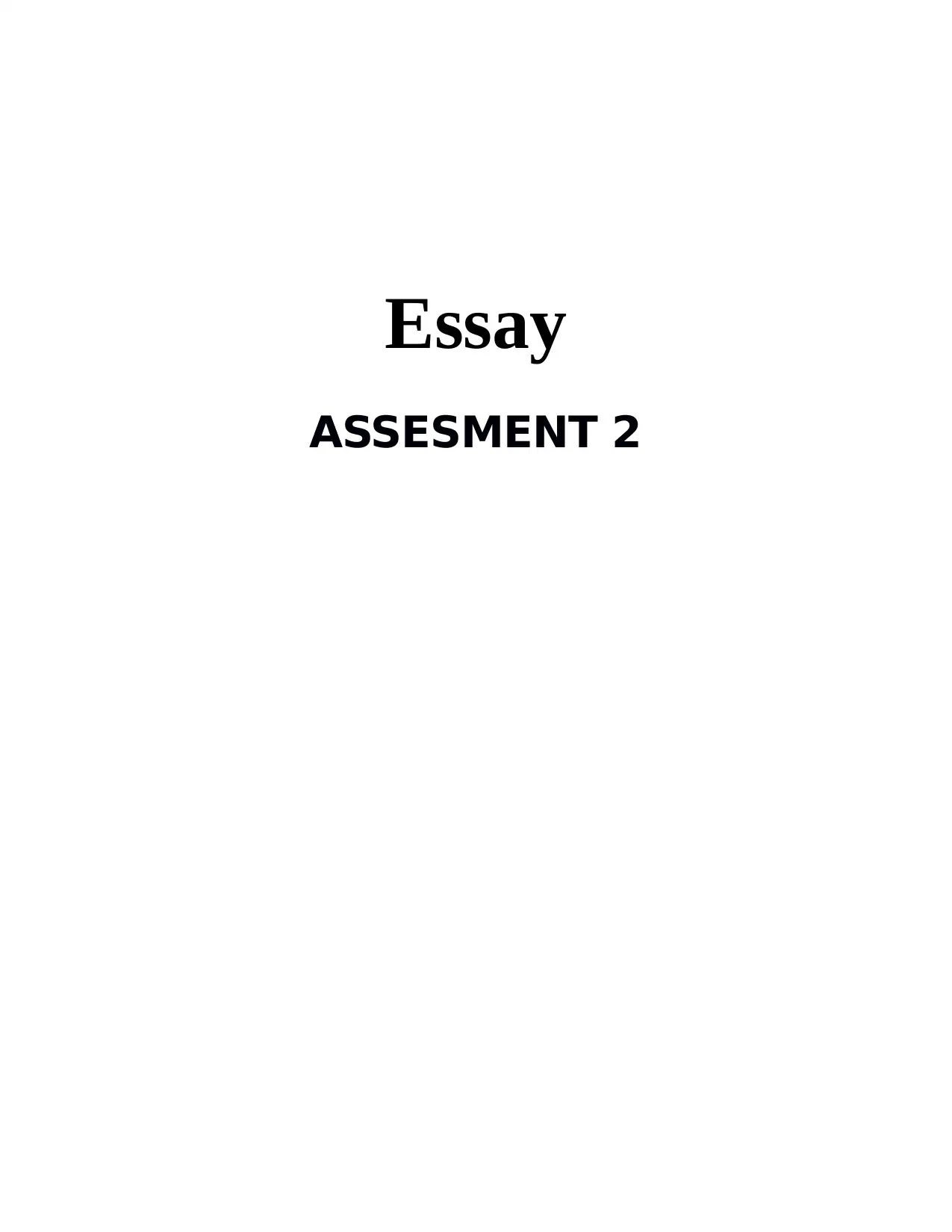
Essay
ASSESMENT 2
ASSESMENT 2
Secure Best Marks with AI Grader
Need help grading? Try our AI Grader for instant feedback on your assignments.
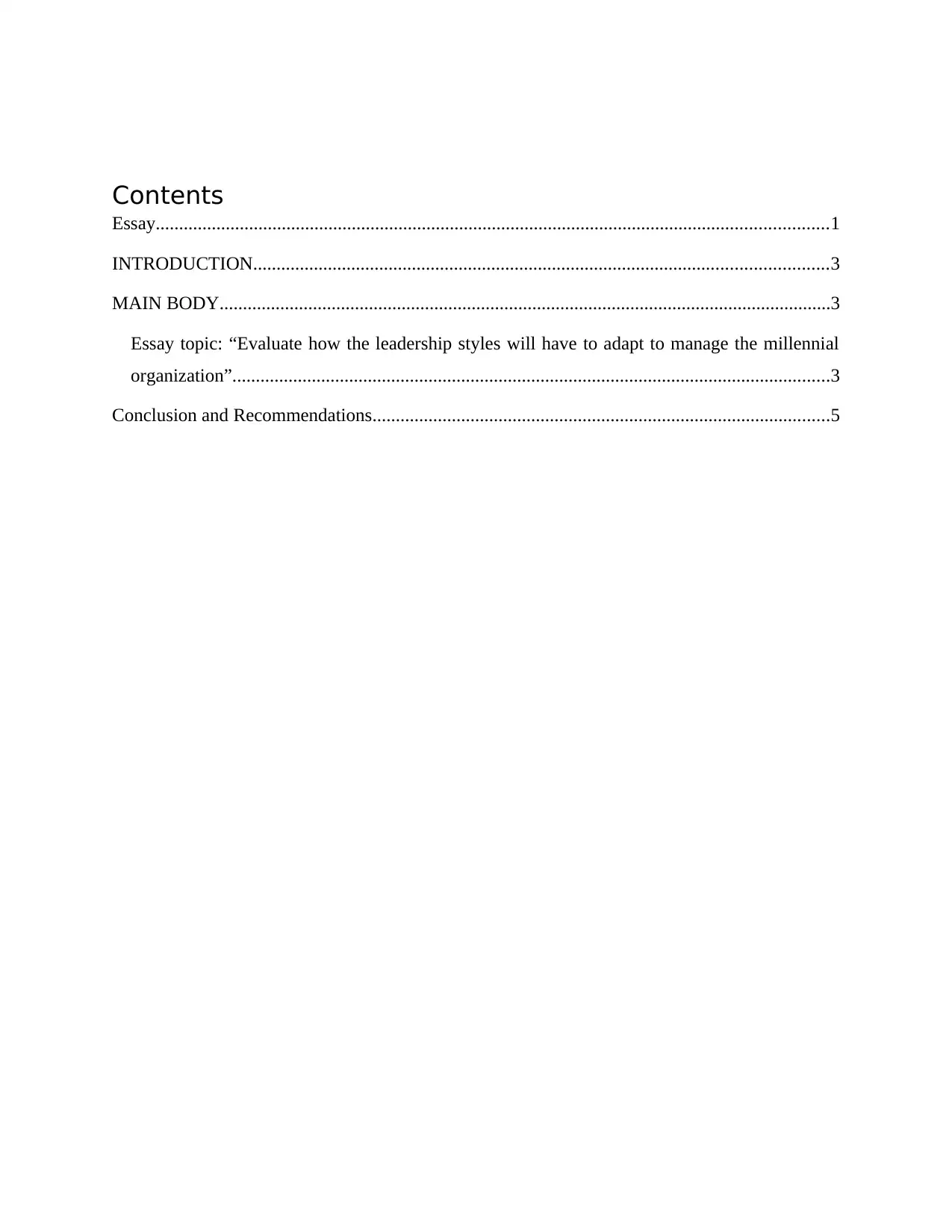
Contents
Essay................................................................................................................................................1
INTRODUCTION...........................................................................................................................3
MAIN BODY...................................................................................................................................3
Essay topic: “Evaluate how the leadership styles will have to adapt to manage the millennial
organization”................................................................................................................................3
Conclusion and Recommendations..................................................................................................5
Essay................................................................................................................................................1
INTRODUCTION...........................................................................................................................3
MAIN BODY...................................................................................................................................3
Essay topic: “Evaluate how the leadership styles will have to adapt to manage the millennial
organization”................................................................................................................................3
Conclusion and Recommendations..................................................................................................5
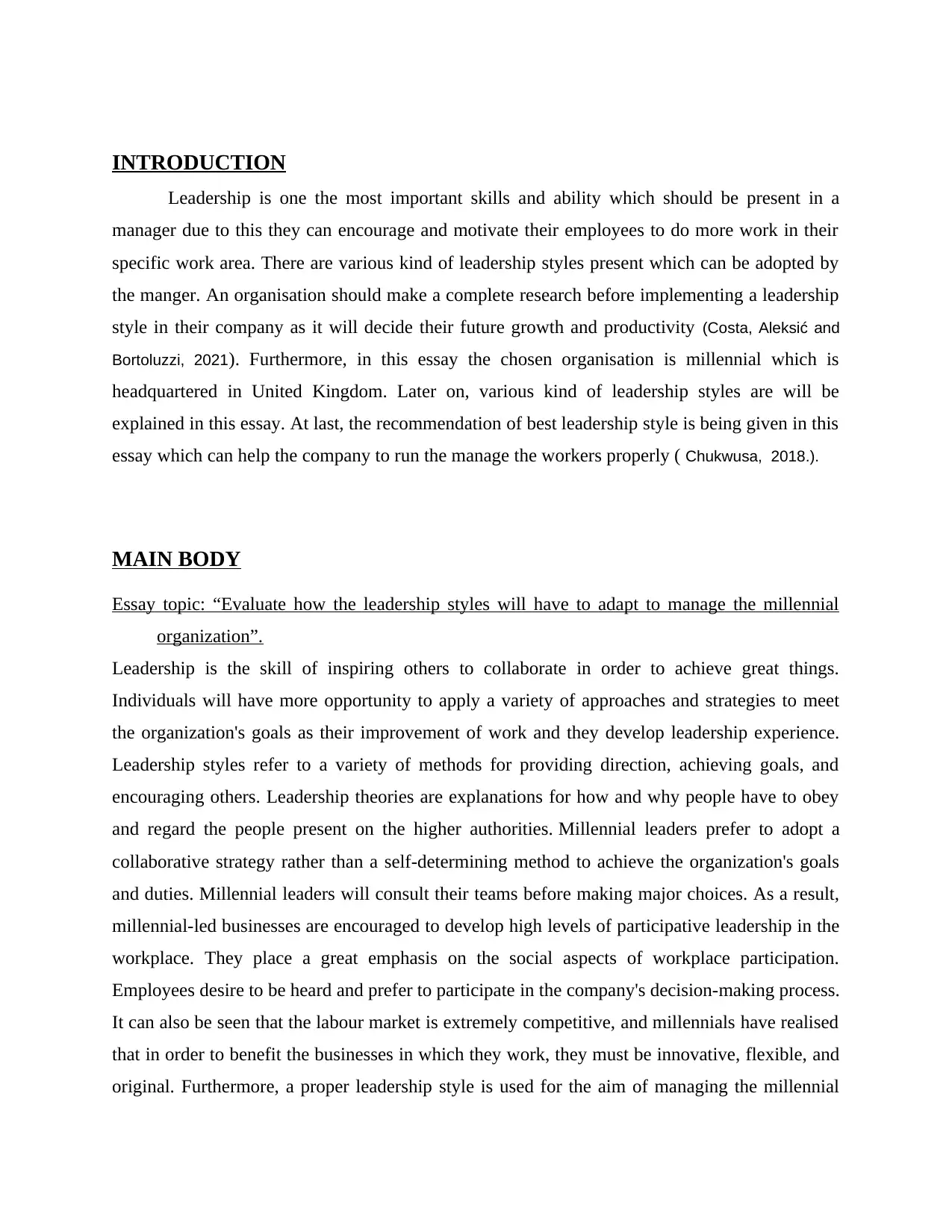
INTRODUCTION
Leadership is one the most important skills and ability which should be present in a
manager due to this they can encourage and motivate their employees to do more work in their
specific work area. There are various kind of leadership styles present which can be adopted by
the manger. An organisation should make a complete research before implementing a leadership
style in their company as it will decide their future growth and productivity (Costa, Aleksić and
Bortoluzzi, 2021). Furthermore, in this essay the chosen organisation is millennial which is
headquartered in United Kingdom. Later on, various kind of leadership styles are will be
explained in this essay. At last, the recommendation of best leadership style is being given in this
essay which can help the company to run the manage the workers properly ( Chukwusa, 2018.).
MAIN BODY
Essay topic: “Evaluate how the leadership styles will have to adapt to manage the millennial
organization”.
Leadership is the skill of inspiring others to collaborate in order to achieve great things.
Individuals will have more opportunity to apply a variety of approaches and strategies to meet
the organization's goals as their improvement of work and they develop leadership experience.
Leadership styles refer to a variety of methods for providing direction, achieving goals, and
encouraging others. Leadership theories are explanations for how and why people have to obey
and regard the people present on the higher authorities. Millennial leaders prefer to adopt a
collaborative strategy rather than a self-determining method to achieve the organization's goals
and duties. Millennial leaders will consult their teams before making major choices. As a result,
millennial-led businesses are encouraged to develop high levels of participative leadership in the
workplace. They place a great emphasis on the social aspects of workplace participation.
Employees desire to be heard and prefer to participate in the company's decision-making process.
It can also be seen that the labour market is extremely competitive, and millennials have realised
that in order to benefit the businesses in which they work, they must be innovative, flexible, and
original. Furthermore, a proper leadership style is used for the aim of managing the millennial
Leadership is one the most important skills and ability which should be present in a
manager due to this they can encourage and motivate their employees to do more work in their
specific work area. There are various kind of leadership styles present which can be adopted by
the manger. An organisation should make a complete research before implementing a leadership
style in their company as it will decide their future growth and productivity (Costa, Aleksić and
Bortoluzzi, 2021). Furthermore, in this essay the chosen organisation is millennial which is
headquartered in United Kingdom. Later on, various kind of leadership styles are will be
explained in this essay. At last, the recommendation of best leadership style is being given in this
essay which can help the company to run the manage the workers properly ( Chukwusa, 2018.).
MAIN BODY
Essay topic: “Evaluate how the leadership styles will have to adapt to manage the millennial
organization”.
Leadership is the skill of inspiring others to collaborate in order to achieve great things.
Individuals will have more opportunity to apply a variety of approaches and strategies to meet
the organization's goals as their improvement of work and they develop leadership experience.
Leadership styles refer to a variety of methods for providing direction, achieving goals, and
encouraging others. Leadership theories are explanations for how and why people have to obey
and regard the people present on the higher authorities. Millennial leaders prefer to adopt a
collaborative strategy rather than a self-determining method to achieve the organization's goals
and duties. Millennial leaders will consult their teams before making major choices. As a result,
millennial-led businesses are encouraged to develop high levels of participative leadership in the
workplace. They place a great emphasis on the social aspects of workplace participation.
Employees desire to be heard and prefer to participate in the company's decision-making process.
It can also be seen that the labour market is extremely competitive, and millennials have realised
that in order to benefit the businesses in which they work, they must be innovative, flexible, and
original. Furthermore, a proper leadership style is used for the aim of managing the millennial
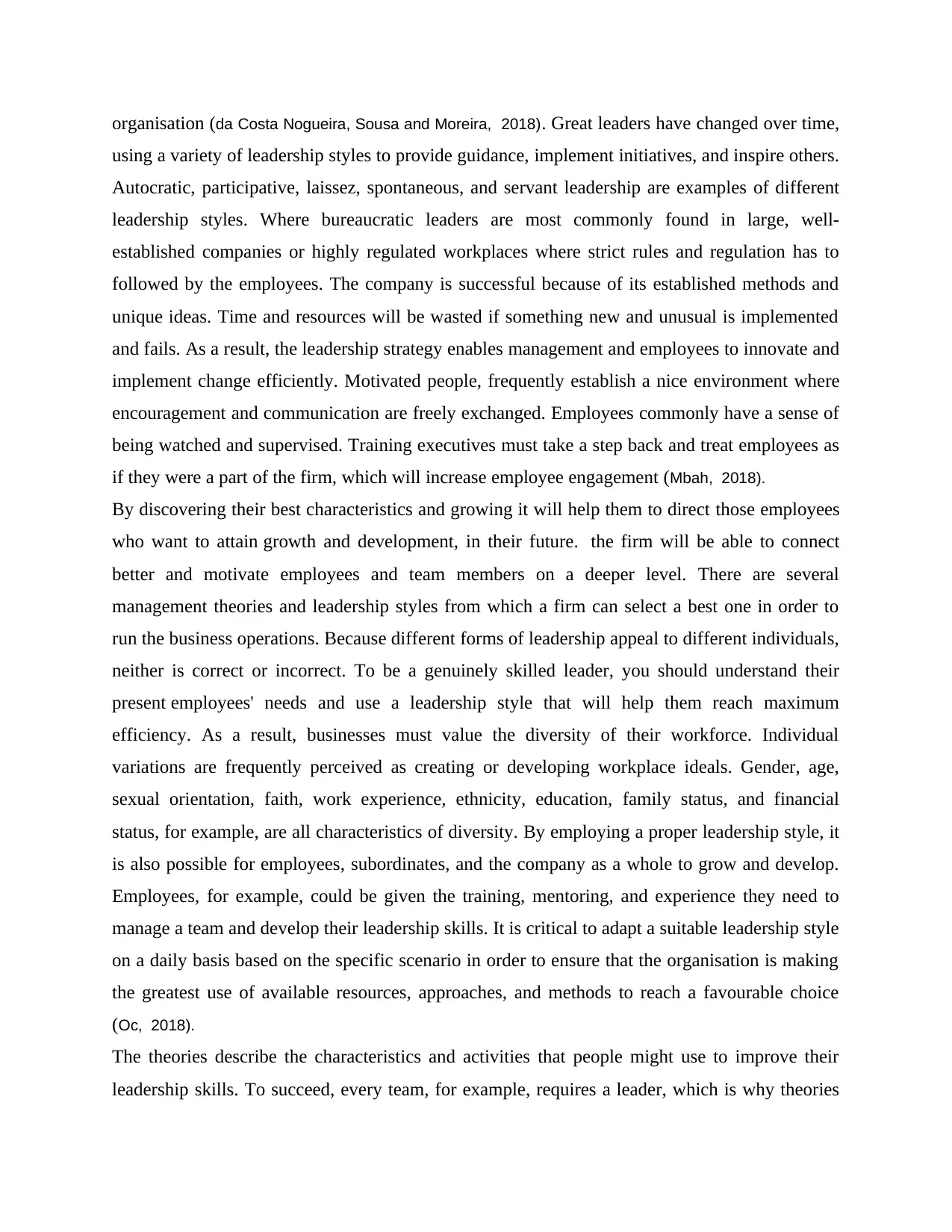
organisation (da Costa Nogueira, Sousa and Moreira, 2018). Great leaders have changed over time,
using a variety of leadership styles to provide guidance, implement initiatives, and inspire others.
Autocratic, participative, laissez, spontaneous, and servant leadership are examples of different
leadership styles. Where bureaucratic leaders are most commonly found in large, well-
established companies or highly regulated workplaces where strict rules and regulation has to
followed by the employees. The company is successful because of its established methods and
unique ideas. Time and resources will be wasted if something new and unusual is implemented
and fails. As a result, the leadership strategy enables management and employees to innovate and
implement change efficiently. Motivated people, frequently establish a nice environment where
encouragement and communication are freely exchanged. Employees commonly have a sense of
being watched and supervised. Training executives must take a step back and treat employees as
if they were a part of the firm, which will increase employee engagement (Mbah, 2018).
By discovering their best characteristics and growing it will help them to direct those employees
who want to attain growth and development, in their future. the firm will be able to connect
better and motivate employees and team members on a deeper level. There are several
management theories and leadership styles from which a firm can select a best one in order to
run the business operations. Because different forms of leadership appeal to different individuals,
neither is correct or incorrect. To be a genuinely skilled leader, you should understand their
present employees' needs and use a leadership style that will help them reach maximum
efficiency. As a result, businesses must value the diversity of their workforce. Individual
variations are frequently perceived as creating or developing workplace ideals. Gender, age,
sexual orientation, faith, work experience, ethnicity, education, family status, and financial
status, for example, are all characteristics of diversity. By employing a proper leadership style, it
is also possible for employees, subordinates, and the company as a whole to grow and develop.
Employees, for example, could be given the training, mentoring, and experience they need to
manage a team and develop their leadership skills. It is critical to adapt a suitable leadership style
on a daily basis based on the specific scenario in order to ensure that the organisation is making
the greatest use of available resources, approaches, and methods to reach a favourable choice
(Oc, 2018).
The theories describe the characteristics and activities that people might use to improve their
leadership skills. To succeed, every team, for example, requires a leader, which is why theories
using a variety of leadership styles to provide guidance, implement initiatives, and inspire others.
Autocratic, participative, laissez, spontaneous, and servant leadership are examples of different
leadership styles. Where bureaucratic leaders are most commonly found in large, well-
established companies or highly regulated workplaces where strict rules and regulation has to
followed by the employees. The company is successful because of its established methods and
unique ideas. Time and resources will be wasted if something new and unusual is implemented
and fails. As a result, the leadership strategy enables management and employees to innovate and
implement change efficiently. Motivated people, frequently establish a nice environment where
encouragement and communication are freely exchanged. Employees commonly have a sense of
being watched and supervised. Training executives must take a step back and treat employees as
if they were a part of the firm, which will increase employee engagement (Mbah, 2018).
By discovering their best characteristics and growing it will help them to direct those employees
who want to attain growth and development, in their future. the firm will be able to connect
better and motivate employees and team members on a deeper level. There are several
management theories and leadership styles from which a firm can select a best one in order to
run the business operations. Because different forms of leadership appeal to different individuals,
neither is correct or incorrect. To be a genuinely skilled leader, you should understand their
present employees' needs and use a leadership style that will help them reach maximum
efficiency. As a result, businesses must value the diversity of their workforce. Individual
variations are frequently perceived as creating or developing workplace ideals. Gender, age,
sexual orientation, faith, work experience, ethnicity, education, family status, and financial
status, for example, are all characteristics of diversity. By employing a proper leadership style, it
is also possible for employees, subordinates, and the company as a whole to grow and develop.
Employees, for example, could be given the training, mentoring, and experience they need to
manage a team and develop their leadership skills. It is critical to adapt a suitable leadership style
on a daily basis based on the specific scenario in order to ensure that the organisation is making
the greatest use of available resources, approaches, and methods to reach a favourable choice
(Oc, 2018).
The theories describe the characteristics and activities that people might use to improve their
leadership skills. To succeed, every team, for example, requires a leader, which is why theories
Secure Best Marks with AI Grader
Need help grading? Try our AI Grader for instant feedback on your assignments.
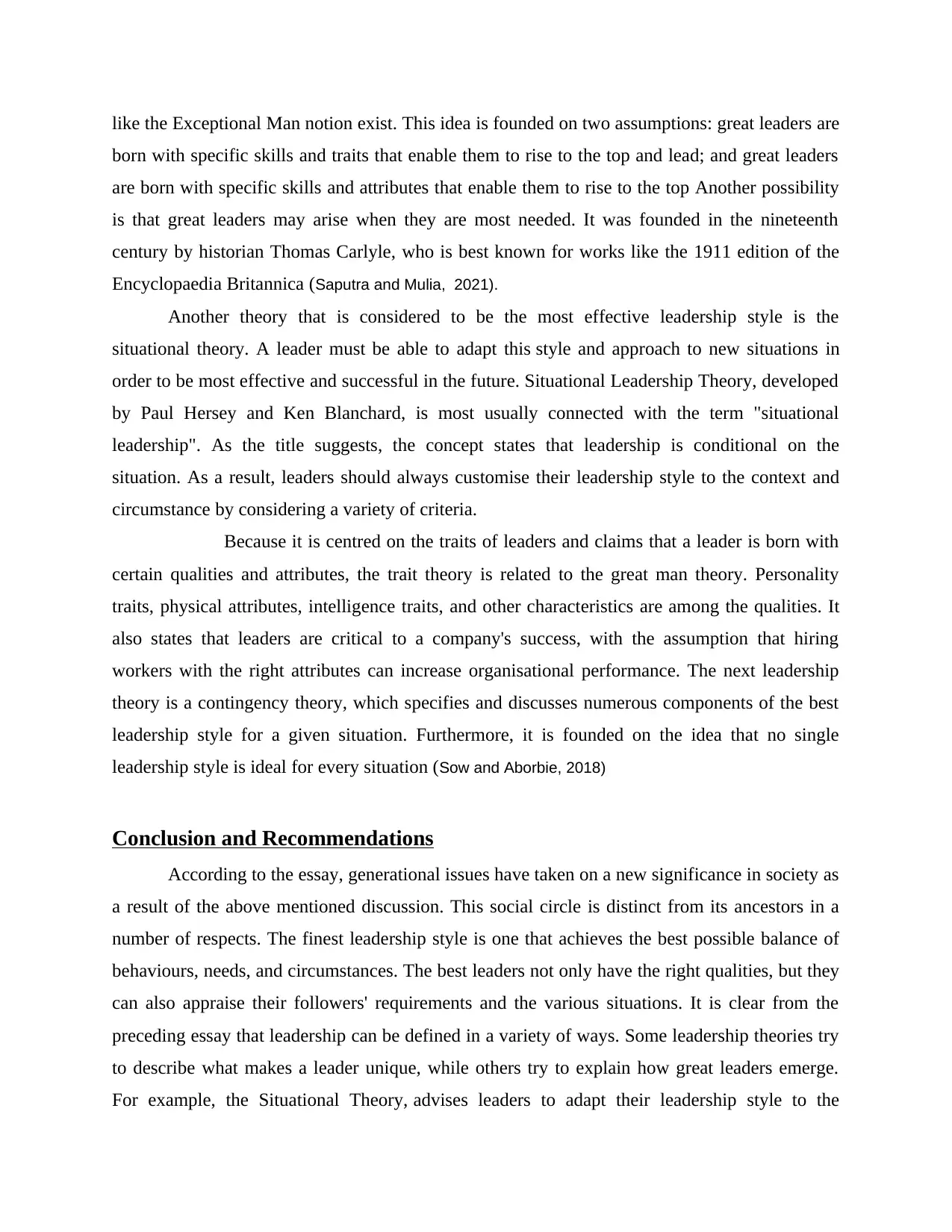
like the Exceptional Man notion exist. This idea is founded on two assumptions: great leaders are
born with specific skills and traits that enable them to rise to the top and lead; and great leaders
are born with specific skills and attributes that enable them to rise to the top Another possibility
is that great leaders may arise when they are most needed. It was founded in the nineteenth
century by historian Thomas Carlyle, who is best known for works like the 1911 edition of the
Encyclopaedia Britannica (Saputra and Mulia, 2021).
Another theory that is considered to be the most effective leadership style is the
situational theory. A leader must be able to adapt this style and approach to new situations in
order to be most effective and successful in the future. Situational Leadership Theory, developed
by Paul Hersey and Ken Blanchard, is most usually connected with the term "situational
leadership". As the title suggests, the concept states that leadership is conditional on the
situation. As a result, leaders should always customise their leadership style to the context and
circumstance by considering a variety of criteria.
Because it is centred on the traits of leaders and claims that a leader is born with
certain qualities and attributes, the trait theory is related to the great man theory. Personality
traits, physical attributes, intelligence traits, and other characteristics are among the qualities. It
also states that leaders are critical to a company's success, with the assumption that hiring
workers with the right attributes can increase organisational performance. The next leadership
theory is a contingency theory, which specifies and discusses numerous components of the best
leadership style for a given situation. Furthermore, it is founded on the idea that no single
leadership style is ideal for every situation (Sow and Aborbie, 2018)
Conclusion and Recommendations
According to the essay, generational issues have taken on a new significance in society as
a result of the above mentioned discussion. This social circle is distinct from its ancestors in a
number of respects. The finest leadership style is one that achieves the best possible balance of
behaviours, needs, and circumstances. The best leaders not only have the right qualities, but they
can also appraise their followers' requirements and the various situations. It is clear from the
preceding essay that leadership can be defined in a variety of ways. Some leadership theories try
to describe what makes a leader unique, while others try to explain how great leaders emerge.
For example, the Situational Theory, advises leaders to adapt their leadership style to the
born with specific skills and traits that enable them to rise to the top and lead; and great leaders
are born with specific skills and attributes that enable them to rise to the top Another possibility
is that great leaders may arise when they are most needed. It was founded in the nineteenth
century by historian Thomas Carlyle, who is best known for works like the 1911 edition of the
Encyclopaedia Britannica (Saputra and Mulia, 2021).
Another theory that is considered to be the most effective leadership style is the
situational theory. A leader must be able to adapt this style and approach to new situations in
order to be most effective and successful in the future. Situational Leadership Theory, developed
by Paul Hersey and Ken Blanchard, is most usually connected with the term "situational
leadership". As the title suggests, the concept states that leadership is conditional on the
situation. As a result, leaders should always customise their leadership style to the context and
circumstance by considering a variety of criteria.
Because it is centred on the traits of leaders and claims that a leader is born with
certain qualities and attributes, the trait theory is related to the great man theory. Personality
traits, physical attributes, intelligence traits, and other characteristics are among the qualities. It
also states that leaders are critical to a company's success, with the assumption that hiring
workers with the right attributes can increase organisational performance. The next leadership
theory is a contingency theory, which specifies and discusses numerous components of the best
leadership style for a given situation. Furthermore, it is founded on the idea that no single
leadership style is ideal for every situation (Sow and Aborbie, 2018)
Conclusion and Recommendations
According to the essay, generational issues have taken on a new significance in society as
a result of the above mentioned discussion. This social circle is distinct from its ancestors in a
number of respects. The finest leadership style is one that achieves the best possible balance of
behaviours, needs, and circumstances. The best leaders not only have the right qualities, but they
can also appraise their followers' requirements and the various situations. It is clear from the
preceding essay that leadership can be defined in a variety of ways. Some leadership theories try
to describe what makes a leader unique, while others try to explain how great leaders emerge.
For example, the Situational Theory, advises leaders to adapt their leadership style to the
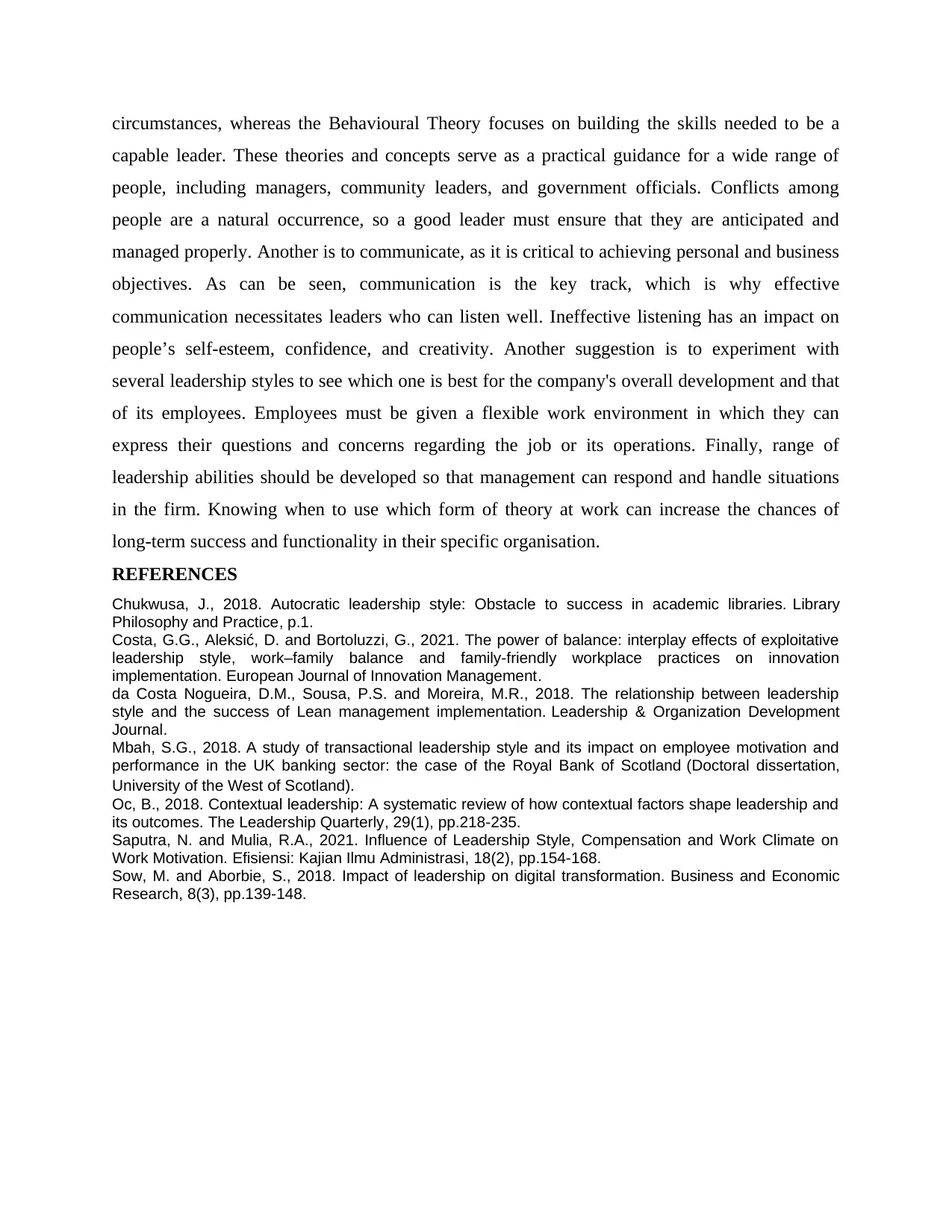
circumstances, whereas the Behavioural Theory focuses on building the skills needed to be a
capable leader. These theories and concepts serve as a practical guidance for a wide range of
people, including managers, community leaders, and government officials. Conflicts among
people are a natural occurrence, so a good leader must ensure that they are anticipated and
managed properly. Another is to communicate, as it is critical to achieving personal and business
objectives. As can be seen, communication is the key track, which is why effective
communication necessitates leaders who can listen well. Ineffective listening has an impact on
people’s self-esteem, confidence, and creativity. Another suggestion is to experiment with
several leadership styles to see which one is best for the company's overall development and that
of its employees. Employees must be given a flexible work environment in which they can
express their questions and concerns regarding the job or its operations. Finally, range of
leadership abilities should be developed so that management can respond and handle situations
in the firm. Knowing when to use which form of theory at work can increase the chances of
long-term success and functionality in their specific organisation.
REFERENCES
Chukwusa, J., 2018. Autocratic leadership style: Obstacle to success in academic libraries. Library
Philosophy and Practice, p.1.
Costa, G.G., Aleksić, D. and Bortoluzzi, G., 2021. The power of balance: interplay effects of exploitative
leadership style, work–family balance and family-friendly workplace practices on innovation
implementation. European Journal of Innovation Management.
da Costa Nogueira, D.M., Sousa, P.S. and Moreira, M.R., 2018. The relationship between leadership
style and the success of Lean management implementation. Leadership & Organization Development
Journal.
Mbah, S.G., 2018. A study of transactional leadership style and its impact on employee motivation and
performance in the UK banking sector: the case of the Royal Bank of Scotland (Doctoral dissertation,
University of the West of Scotland).
Oc, B., 2018. Contextual leadership: A systematic review of how contextual factors shape leadership and
its outcomes. The Leadership Quarterly, 29(1), pp.218-235.
Saputra, N. and Mulia, R.A., 2021. Influence of Leadership Style, Compensation and Work Climate on
Work Motivation. Efisiensi: Kajian Ilmu Administrasi, 18(2), pp.154-168.
Sow, M. and Aborbie, S., 2018. Impact of leadership on digital transformation. Business and Economic
Research, 8(3), pp.139-148.
capable leader. These theories and concepts serve as a practical guidance for a wide range of
people, including managers, community leaders, and government officials. Conflicts among
people are a natural occurrence, so a good leader must ensure that they are anticipated and
managed properly. Another is to communicate, as it is critical to achieving personal and business
objectives. As can be seen, communication is the key track, which is why effective
communication necessitates leaders who can listen well. Ineffective listening has an impact on
people’s self-esteem, confidence, and creativity. Another suggestion is to experiment with
several leadership styles to see which one is best for the company's overall development and that
of its employees. Employees must be given a flexible work environment in which they can
express their questions and concerns regarding the job or its operations. Finally, range of
leadership abilities should be developed so that management can respond and handle situations
in the firm. Knowing when to use which form of theory at work can increase the chances of
long-term success and functionality in their specific organisation.
REFERENCES
Chukwusa, J., 2018. Autocratic leadership style: Obstacle to success in academic libraries. Library
Philosophy and Practice, p.1.
Costa, G.G., Aleksić, D. and Bortoluzzi, G., 2021. The power of balance: interplay effects of exploitative
leadership style, work–family balance and family-friendly workplace practices on innovation
implementation. European Journal of Innovation Management.
da Costa Nogueira, D.M., Sousa, P.S. and Moreira, M.R., 2018. The relationship between leadership
style and the success of Lean management implementation. Leadership & Organization Development
Journal.
Mbah, S.G., 2018. A study of transactional leadership style and its impact on employee motivation and
performance in the UK banking sector: the case of the Royal Bank of Scotland (Doctoral dissertation,
University of the West of Scotland).
Oc, B., 2018. Contextual leadership: A systematic review of how contextual factors shape leadership and
its outcomes. The Leadership Quarterly, 29(1), pp.218-235.
Saputra, N. and Mulia, R.A., 2021. Influence of Leadership Style, Compensation and Work Climate on
Work Motivation. Efisiensi: Kajian Ilmu Administrasi, 18(2), pp.154-168.
Sow, M. and Aborbie, S., 2018. Impact of leadership on digital transformation. Business and Economic
Research, 8(3), pp.139-148.
1 out of 6
Related Documents
Your All-in-One AI-Powered Toolkit for Academic Success.
+13062052269
info@desklib.com
Available 24*7 on WhatsApp / Email
![[object Object]](/_next/static/media/star-bottom.7253800d.svg)
Unlock your academic potential
© 2024 | Zucol Services PVT LTD | All rights reserved.





